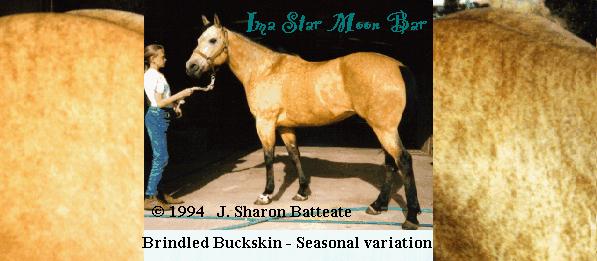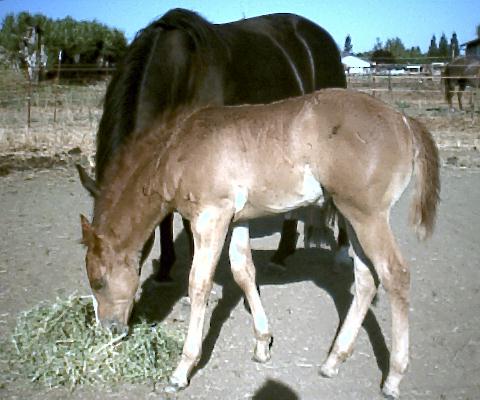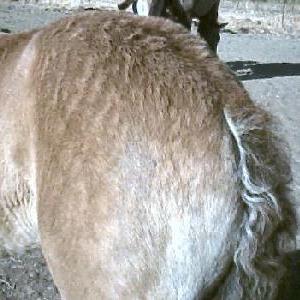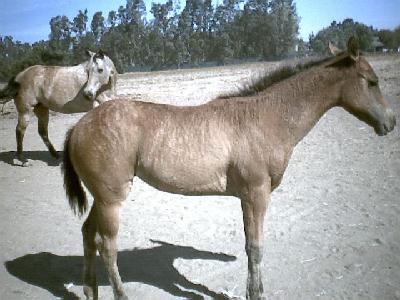


Star has produced three foals to date, 2 of which carry her seasonal pattern. This indicates there may be a gene involved, which is inherited dominately, since approximately 50% of her foals have inherited the pattern from her. In addition, one of her colts has also produced brindled foals, indicating the pattern is capable of being passed from generation to generation, also lending support to the idea of gene for brindle. Below is a summary of Star's offspring.
1995 Grullo AQHA (3363744) Seasonal Brindle daughter of Star by the AQHA grullo stallion Miracle Moon. Like Star, her brindle pattern is seasonal, so usually you cannot see any darker striping on her coat. However, she has coat texturing which is visible (on close observation) year round, although without the darker striping, it is easily missed. Candy has also developed more striping as she has gotten older, so seasonally when the darker striping does appear, it is more noticeable.
1997 mahogany bay AQHA stallion (3625847) out of Star by the seal brown roan AQHA stallion Malbec's Silvery Moon. He is a solid mahogany bay color with no white hairs on his body at all, only a small star on his forehead, indicating he did not inherit the roan gene from his sire. However, I thought he might be a carrier of Star's type of brindle pattern (seasonal brindle) because of his unusual curly texturing on his legs, and his sparser mane and tail (like his dam Star). However, he doesn't actually exhibit any striping himself (not even seasonally). I had to wait until he was old enough to do test breedings to confirm if he was a carrier of the seasonal brindle pattern or not. He has sired five foals to date, reproducing the seasonal brindle pattern on non-brindle mares, indicating that he is indeed a carrier of the seasonal brindle pattern.
2A. His first foal that arrived in 2000, "Millie" (Brenda's Millennium), is out of the brindle mare (Brenda Batty Atty). She is registered in the Half Quarter Registry (12502 1/2). This is the best colored foal I have ever gotten out of Brenda. Millie also exhibits the curly texturing and sparser mane and tail, so she is perhaps a combination of the two types of brindled patterns.


2B. His second foal that arrived in 2001, (Shadow's One), is a bay with the seasonal brindle pattern out of a non-brindled black mare (Brenda's Shadow). She is registered in the Half Quarter Registry (12501 1/2). This foal has the same seasonal brindle pattern as Star (his dam), indicating he is a carrier of Star's type of brindle pattern and is capable of passing it on, even though he is not visibly striped himself.


2C. He has sired three foals in 2003. The first is a red colt (Shadow's Red Man) out of the same non-brindled black mare (Brenda's Shadow) as Shadow's One above. He is registered in the Half Quarter Registry (12618 1/2). The colt exhibited indeterminate coat texturing as a foal, but it is too early to tell if he carries the seasonal brindle pattern. As with his sire, who also does not exhibit visible striping, we may have to wait until he is old enough to do test breedings to see if he is a carrier.

2D. His second foal in 2003 (Brenda's Girly Girl) is out of a brindle mare (Brenda Batty Atty), and is thus a full sister to Millie (shown previously). She is registered in the Half Quarter Registry (12619 1/2) and the IBHA (A-23667). While the foal is Brindle, it appears she has only inherited Brenda's type of brindle pattern, and is probably not a combination of both types as Millie probably is.


2E. His third foal in 2003 (Brindle Batty Atty) is out of a non-brindle mare (Going Batty Atty). She is registered in the AQHA (4393424) as a dun. She inherited the dun factor from her grullo dam, but she is also starting to exhibit the seasonal brindle pattern from her sire.

1999 smoky black AQHA colt (3789286) out of Star by the same seal brown roan AQHA stallion as Ima Star Brindle Bar above. While this horse is a full brother to the above stallion, he is non-brindle. His color is unusual, however, and a lot of people think he is a liver chestnut. His base color is actually black, and he appears to have gotten the Ccr (buckskin/palomino) dilution from Star, so he shows the brownish color some smoky blacks will appear. Usually the Ccr dilution has little effect on black pigment (the reason the points on a buckskin stay black). However, sometimes they will appear brownish, like this colt.
|
The Brindle pattern consists of a watery or drippy looking striping (sometimes just partial striping) over the body of an animal. It is more commonly seen in dogs or cattle. In horses, the pattern is extremely rare. Brindle has occurred in such diverse breeds as Arabians, Thoroughbreds, Mustangs, Quarter Horses, Tennessee Walking Horses, German and Bavarian Warmbloods, Russian Horses, Spanish Horses, and also in Donkeys and Mules.
Many people confuse the Brindle pattern with Dun Factor markings (stripe down the back, barring on the legs, and occasional regular-spaced striping down the ribs). At one time, it was thought Brindle was a just a variation of Dun Factor. Indeed, there have been many examples of horses that were probably carrying both Dun Factor and Brindle. However, as can be seen from pictures of numerous Brindles in our slideshow, many do not have any Dun Factor markings whatsoever, indicating the two patterns are probably distinct genetically.
Brindle horses also have texturing in their coat, similar to that seen in some Appaloosa horses. The pattern seems to be inheritable, especially in terms of coat texturing, but the expression of the darker or more intense pigment to make the pattern visible is highly variable, and even varies with individual horses seasonally / yearly. Sometimes the pattern seems to be composed of dark hair (black or brown), sometimes of white hair (roan or gray).
Information collected since 1990 on Brindle horses is now shedding some light on the Brindle pattern. It now appears there may be two ways in which a Brindle phenotype (outward appearance) can occur. In some horses, the pattern has not been inheritable, pointing to a possible mosaic or chimera origin, such as seen in tortoiseshell cats. In other horses, the pattern has been shown to be inheritable. However, there could be several genes involved, producing similar patterns (much as pinto/paint spotting can result from several different genes). For more information on Brindle Horses, visit the Brindle Horse website at http://www.geocities.com/sbatteate
Written information was last updated © October 6, 2003.
Unless otherwise noted, the articles on this site are by J. Sharon Batteate [email protected] The pictures and information on this site are for informational purposes, in order to educate people on the Brindle pattern. The pictures and information on this site are copyrighted. All rights reserved. No part may be reproduced, stored in a retrieval system, or transmitted in any form or by any means, electronic, mechanical, photocopying, recording, or otherwise, without the prior permission of the copyright holders.
You may also contact me: (209) 477-1536, J. Sharon Batteate, PO Box 8535, Stockton, CA 95208 USA